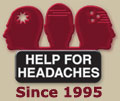Barbaranne Branca, Ph.D., DABFE, DABFM
Michigan HeadPain and Neurological Institute
Ann Arbor, Michigan USA
With chronic pain, despair and guilt haunt many patients. A pain attack can persist for hours, days, even weeks. Pursuits with others--simple conversations, business dinners, games with children, or pursuits alone--doing a craft, enjoying the starry night sky—all activities are affected. Even if you stoically pursue life’s activities, pain halves the pleasure and your spontaneous participation. Your become depressed and frustrated and find yourself taking it out on others. You hear yourself responding with irritation to your spouse’s question, with anger to your children’s normal rushing through the house, and with anxiety as you make an excuse to withdraw from another family get-together. At work, the report is not as thorough as you know you are capable; in the afternoon, when the headache is worse, you function even less well, shuffling papers, putting off more complex tasks. You wrestle with yourself: do you take your medicine and risk being drowsy and even less effective? The inability to escape the pain once again, to avoid the headache disorder diagnosis altogether, and the far-reaching effect it has on your life, your work, and your loved ones causes tremendous suffering.
The myriad of decisions involved in managing a pain disorder on a day-to-day basis may seem overwhelming. Do I have enough energy to clean the closet without increasing my headache? Should I take an extra pain pill? How do I explain this to my son? Should I try to finish my taxes tonight? Conversely, it may seem that the pain takes away freedom to make decisions.
What do we do when we come to realize that there really is no “magic pill” for pain? Research and clinical experience shows that behavioral medicine can have a powerful effect on pain. Behavioral medicine examines and trains us to become aware of and to use the power of our minds and emotions on our physical health. One potent tool in recovering health is training in meditation.
Meditation is a form of paying attention, of becoming aware, and of directing consciousness. Dr. Kabat-Zinn directs the Stress Reduction Clinic at the University of Massachusetts Medical Center and uses mindfulness meditation to help patients who have chronic pain and stress. Mindfulness meditation is paying attention from moment-to-moment. This is carried out in conjunction with medical treatment to manage pain. Recommendations in this paper reinforce what has been in shown in research—that the combination of both medical and behavioral medicine treatment is the most effective in pain management.
Dr. Kabat-Zinn’s results speak for themselves. He has run 8 week training sessions in mindfulness meditation for many years. To examine the effect of mindfulness to modulate pain, a pain questionnaire (McGill-Melzack Pain Rating Index or PRI) is given. In one study, 72% of chronic pain patients reported a 33% reduction on their PRI scores. Scores on negative body image (how patients rated different parts of their body as problematic) were 30% lower by the end of the program. For people who have strong negative feelings about their body and are upset because their painful body/head holds them back from living, this is an impressive score in such a short period of time. A 30% improvement in the ability to engage in normal activities of daily living like cooking, driving, sex, and sleeping was reported. Mood was significantly improved (55%); negative feelings (anxiety, depression, anger) dropped, positive feelings increased, and preoccupation with health thoughts decreased. By the end of the program, people reported taking less pain medication, being more active, and feeling better overall.
Mindfulness meditation has a positive effect on multiple levels of a person’s life. A large study (Reibel and colleagues, 2001) involved 136 patients, with a mix of chronic health problems. They learned mindfulness based stress reduction in an 8 week program and practiced meditation 20 minutes a day. Their responses were compared before and after on a health survey, medical symptom checklist, and psychological inventory. Health-related quality of life improved greatly; people reported increased energy, reduced body pain, less limited functioning, and increased ability to socialize. Medical symptoms were reduced 28%. Psychological relief was striking, with overall 38% reduction in distress, 44% reduction in anxiety and 34% reduction in depression. Follow-up with these patients a year later indicated that they had sustained these improvements.
A well-controlled study included 90 cancer patients (Speca and colleagues, 2000) who participated in mindfulness meditation to reduce stress and help with emotional distress. The patients had significantly reduced scores (65% less) on overall emotional distress--specifically depression, anxiety, anger, and confusion--and improved scores on vigor, when compared to the cancer patients in the control group (cancer patients who had not learned meditation). On a stress inventory, they reported 31% less stress than the controls. They had fewer cardiopulmonary and gastrointestinal symptoms.
On-the-job stress contributes to absenteeism, reduced productivity, injury, and affects pre-existing chronic disease. Stress management programs implemented at the work site that include relaxation and meditation, exercise, and biofeedback reduces physiological symptoms, for example, hypertension, increases job performance, and self-report of job satisfaction (Stein, 2001).
A pilot study (Creamer and colleagues, 2000) examined the effect of an eight-session treatment package with relaxation/meditation training and a Chinese movement therapy. Twenty fibromyalgia patients who completed 5 out of 8 of the cognitive-behavioral, educationally based sessions improved as seen in pain threshold, tender points, and their responses on the Fibromyalgia Impact Questionnaire. This improvement continued when re-evaluated 4 months later.
There are many resources for learning mindfulness meditation stress reduction. Speak with your behavioral medicine psychologist about learning this, biofeedback, and relaxation. Supplement your discussion by reading Dr. Kabat-Zinn’s book and other resources.
It is advisable to work with guidance. However, you can begin to create your own meditation practice:
- Find a quiet, clean space. You are going to be sitting, either in a chair on the floor. You have to be able to support your spine or make sure your spine is supported. Postural alignment is important and should convey dignity and calm. It is nice to beautify your space—put flowers on a table, for instance. Turn off the phone.
- Practice for 10 minutes to start. Set an alarm so you do not have worry about how much time has passed.
- Focus on the breath. Feel your breath coming in and feel it going out. When your mind wanders, bring your attention back to your breath. You may find that your mind wanders 100 times in 10 minutes; just gently bring your attention back to your breath.
There are many techniques for mindfulness meditation and breathing, some of which are listed below. It really is possible for you to change how you respond to pain and to make a difference in managing your health.
- Creamer, P; Singh, BB, Hochberg, MC, Berman, BM. Sustained improvement produced by nonpharmacologic intervention in fibromyalgia: results of a pilot study. Arthritis Care Res. 2000 Aug; 13(4):198-204
- Durgananda, S. The Heart of Meditation. South Fallsburg, NY:SYDA Foundation, 2002
- Kabat-Zinn, J. Full Catastrophe Living: Using the Wisdom and Your Body and Mind to Face Stress, Pain, and Illness. New York: Bantam, 1990.
- Reibel, DK; Greeson, JM; Brainard GC; Rosenzweig S. Mindfulness-based stress reduction and health-related quality of life in a heterogeneous patient population. Gen Hosp Psychiatry 2001 Jul-Aug;23(4):182-92
- Speca M; Carlson LE; Goodey E; Angen M. A randomized, wait-list controlled clinical trial: the effect of a mindfulness meditation-based stress reduction program on mood and symptoms of stress in cancer outpatients. Psychosom Med 2000 Sep-Oct;62(5):613-22.
- Stein, F. Occupation stress, relaxation therapies, exercise and biofeedback. Work 2001; 17(3):235-245.
- Weil, A. Breathing. (Mark McCoin CD’s, 2002)
Published on the Help For Headaches Web Site
http://www.headache-help.org

